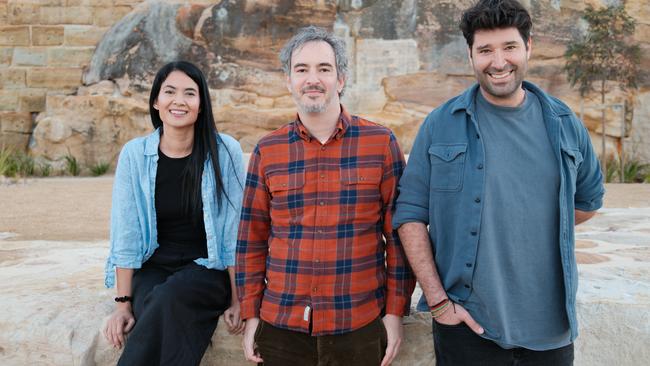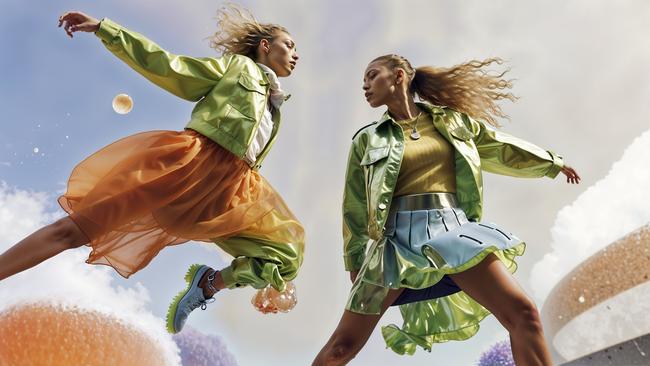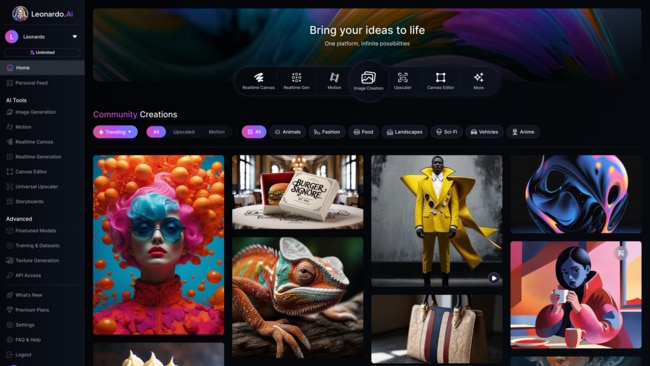Canva takes over Leonardo.AI as threat looms from Microsoft
Canva has doubled down on its artificial intelligence design prowess, taking over a Sydney firm for an undisclosed sum ahead of a potential IPO and as Microsoft nips at its heels.

Australian tech darling Canva has doubled down on its artificial intelligence design prowess, taking over Leonardo.AI ahead of a potential public listing and as Microsoft nips at its heels with its own visual communications app.
Sydney-based Leonardo had been touted as the next Canva, amassing 19 million users since its founding two years ago. But rather than become rivals, the two have joined forces as a threat looms from Microsoft.
Microsoft launched its own AI-powered designer app, which is available across Microsoft 365, iOS and android devices, promising convenience for its 340 million-plus enterprise users.
But Canva is recording strong growth – with more than 180 million monthly active users, and has been on an acquisition spree, which has included acquiring Photoshop rival Affinity last year for an undisclosed sum – as it launches new features at pace.
It plans to lift the number of monthly users to one billion, and in May redesigned its entire platform and launched a suite of new products to take on the lucrative enterprise market.

Canva co-founder and chief product officer Cameron Adams said what Canva and Leonardo offer is different to Microsoft, which Apple co-founder Steve Jobs once branded as having no taste.
“I wouldn’t say they are directly in the spaces that Canva and Leonardo are in,” Mr Adams said.
“On the Canva side, we’ve been working on visual communication and creativity for 12 years now, and we’re the world’s leading platform for it.
“In the visual communications category that Canva has established, it has proven time and time again to be to be more effective.”
Like the Affinity deal, Mr Adams did not disclose the terms of the Leonardo acquisition. He said Canva – valued at about $40bn after an oversubscribed $3.6bn share sale earlier this year that made some of its staff instant millionaires – did not reveal how much it paid for any of its investments.
But he said Leonardo, and its 120 “high-calibre” researchers, engineers and designers would remain independent.
“They have built an amazing product with a really strong community behind it, and we want them to continue doing just that. We would like to tap into what they’ve built – their Phoenix foundation model, we will integrate very quickly into Canva,” he said.
“But we want (Leonardo founder and chief executive) JJ (Fiasson) and the team to continue to fuel that innovation in what AI and creativity looks like … and unlocking more there.”

Leonardo allows users to generate images, with “speed, style and consistency” via simple verbal prompts. Mr Adams said its new foundational model, Phoenix, takes creator control to the next level, with unprecedented prompt adherence, coherent, accurate text in images, and the ability to generate production-ready assets in one shot.
“They’re seriously world class, the product they’ve put out, the models they’ve developed, they go head to head with the world’s best, and even beyond that. So the fact they’ve been able to do that from Sydney is a real testament to the scene we are developing here,” he said.
Leonardo’s customers include film directors, architects and professional designers across a variety of sectors, including fashion and e-commerce, as well as hobbyists.
Mr Adams said Leonardo would complement Canva’s AI-powered product, Magic Studio, which has been used more than seven billion times since it launched last year.
Mr Fiasson said Leonardo was unique because it had combined AI with the end user in mind, unlike others that have open-sourced their technology or partnered with others.
“If you look at the journey of generative AI, especially from a visual content creation perspective, early on it was kind of like a slot machine. You’d enter in a text prompt and you’d probably get a cool picture or something back. But how usable was that?
“The key to broad-scale adoption and productivity is actually giving people more and more control. The more control you give people, the more useful it is as a tool.
“Keeping humans at the centre of creativity is really key as well. And so I think this, this move to greater and greater control, is a really exciting sort of next phase of visual content from a generative AI perspective.”

Mr Fiasson said joining Canva would allow Leonardo to invest “more deeply in scaling our AI research efforts globally, and move even faster to deliver new features and functionality”.
Acquisitions have “elevated and accelerated” Canva’s technology. Other deals include Pexels and Pixabay in 2019, Kaleido, Smartmockups and SlidesCarnival in 2021 and Flourish in 2022. The string of deals prompted Canva to open its first European headquarters in London in 2023.
Blackbird has backed both Canva and Leonardo. A spokeswoman for the fund said the deal was a “classic combination of businesses that just make sense”.
“Leonardo gets the power of Canva’s user base and financial scale, to accelerate its mission of building the best professional-grade image generation platform. Canva gets Leonardo’s world-class tools and model to feed into its products and huge user base, removing some of the reliance on others’ models,” the Blackbird spokeswoman said.
“This acquisition cements Canva as one of the leading AI companies in the world, with its own generative models and leading professional design tools. With an even more ambitious product offering, we see this combination as enhancing Canva’s value considerably.
“At Blackbird, we’re proud to have been major investors in both companies from the very beginning. We’re excited about the value being created by their combination, and it’s exciting to see one of our first-generation portfolio companies acquiring one from the newer generation.”
The Blackbird spokeswoman said while such deals were a “regular phenomenon in Silicon Valley, where many of the top venture capital firms have seen these transactions happen in their portfolio”, it was a new feature in Australia’s tech landscape.
“This is another coming-of-age milestone for the Aussie start-up ecosystem,” she said.





To join the conversation, please log in. Don't have an account? Register
Join the conversation, you are commenting as Logout